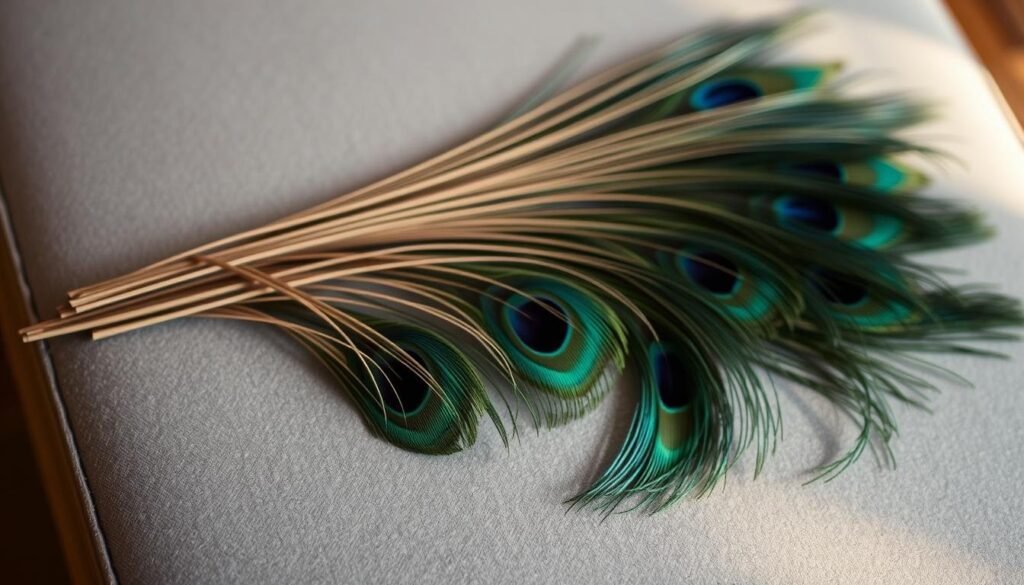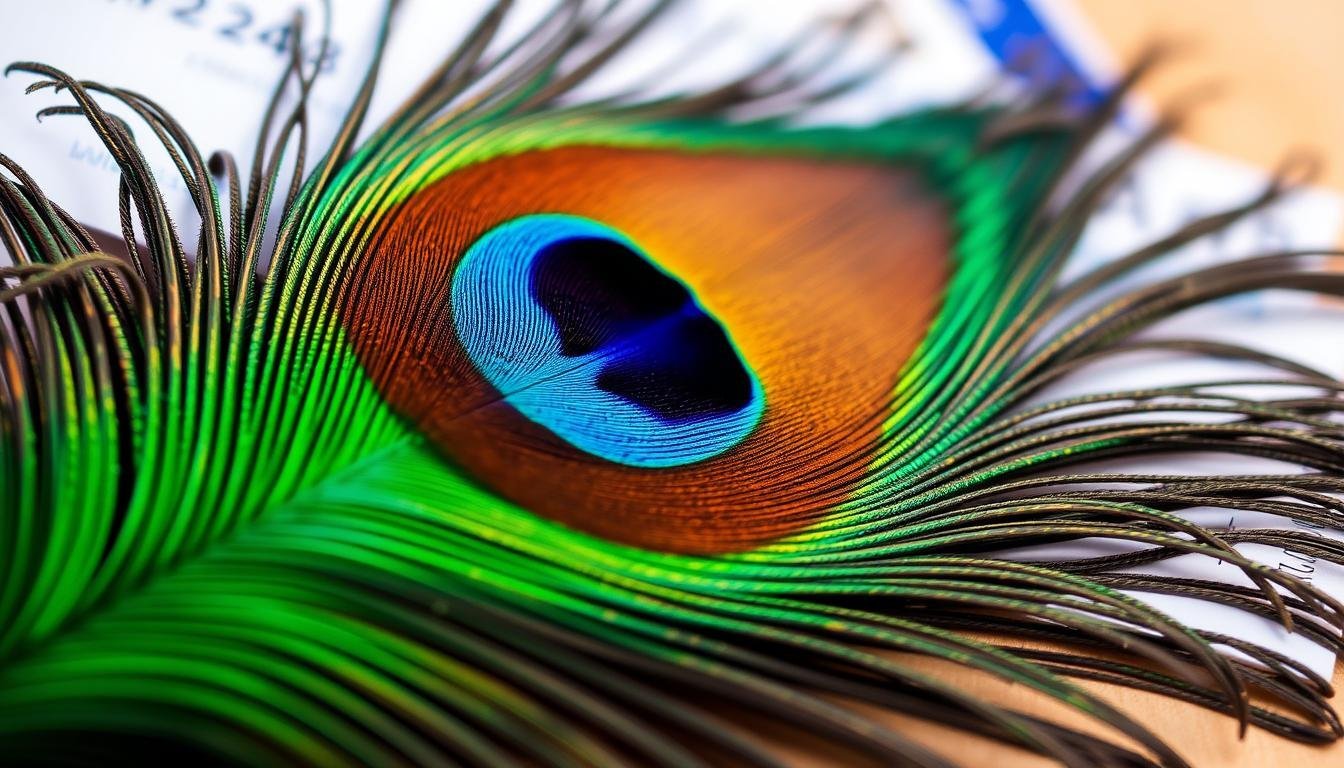Traveling with a Peacock Feather: Are you planning to travel with a unique item, such as a peacock feather? It’s important to know the airline policies before packing such items.
Airline rules can be tricky, especially for items not used every day. If you’re thinking about bringing a peacock feather on your next flight, you’re in good company.
Many people wonder what’s okay and what’s not. Knowing the peacock feather airline policy can help avoid problems at the airport.
Contents
- 1 Understanding Peacock Feather Regulations
- 2 Can You Bring a Peacock Feather on a Plane?
- 3 Navigating Customs and Wildlife Regulations
- 4 How to Properly Pack a Peacock Feather for Air Travel
- 5 Potential Consequences of Non-Compliance
- 6 Conclusion: Traveling with a Peacock Feather
- 7 FAQ
- 7.1 Are peacock feathers allowed in carry-on luggage?
- 7.2 Do I need to declare my peacock feather when going through customs?
- 7.3 Can I bring a peacock feather on an international flight?
- 7.4 What are the consequences of not declaring a peacock feather at customs?
- 7.5 Are there any specific airlines that do not allow peacock feathers on board?
- 7.6 How do I prove that my peacock feather was acquired legally?
Understanding Peacock Feather Regulations
Traveling with a peacock feather? It’s key to know the rules. Feathers from exotic or protected birds like peacocks face strict laws.
In the U.S., the wildlife regulations for feathers change by area. The U.S. Fish and Wildlife Service oversees the movement of wildlife items, including feathers.
To follow feather customs regulations, make sure your feather is legal and declared right. Here’s what you need to know:
| Regulation Aspect | Description | Relevance to Peacock Feathers |
|---|---|---|
| Legal Origin | Feathers must be legally obtained. | Ensure your peacock feather is from a legal source. |
| Declaration | Proper declaration at customs. | Declare your peacock feather at customs checkpoints. |
| Permits | Possession of necessary permits. | Check if a permit is required for your peacock feather. |
Knowing these rules can save you from trouble. Always check with airlines about carrying unique items like peacock feathers.
Can You Bring a Peacock Feather on a Plane?
Thinking about bringing a peacock feather on your next flight? It’s key to know the airline’s rules. The rules for feathers on planes differ a lot between airlines.
Airlines have their own rules for unusual items, like peacock feathers. Some might let you pack feathers in checked luggage but not carry-ons. Always check with your airline before flying to avoid problems.
| Airline | Carry-On Policy | Checked Luggage Policy |
|---|---|---|
| American Airlines | Not allowed due to potential disturbance | Allowed with proper packaging |
| Delta Air Lines | Allowed if properly secured | Allowed |
| United Airlines | Not allowed | Allowed with prior approval |
As shown, the rules differ. It’s always best to err on the side of caution and check with your airline. Make sure feathers are well-packed to avoid damage or trouble.
In short, there’s no one-size-fits-all answer to bringing a peacock feather on a plane. But, by checking with your airline and knowing their rules, you can avoid travel headaches.
Traveling with peacock feathers across borders requires knowing the rules. It’s important to understand wildlife regulations for feathers to avoid legal trouble.
Carrying a peacock feather on a plane means more than just checking if it’s okay. You must also follow customs rules. These rules for feather customs regulations can differ a lot from one country to another.
Proof of Legal Acquisition
Complying with wildlife laws means showing you got the feather legally. You’ll need documents like receipts from licensed sellers or permits from wildlife authorities.
Having these documents ready can make going through customs easier. Keep them handy to avoid any issues during your trip.
Wildlife Import Forms
You might also need to fill out wildlife import forms. These forms help track wildlife products, like feathers.
Make sure to fill out these forms correctly. They ask for details like the feather’s origin and why you’re bringing it. Remember, each country has its own rules, so do your homework on the ones for your destination.
Following these rules can make your trip with a peacock feather smooth. Always check the latest laws before you go, as they can change.
How to Properly Pack a Peacock Feather for Air Travel
Wondering how to carry a peacock feather on a plane? The answer is in how you pack it. You must protect it from harm and follow airline and customs rules.
First, pick a strong, protective case or tube. This will keep the feather safe from bumps and knocks during travel. Wrap the feather in soft, breathable stuff like cloth or paper to add extra protection.

It’s wise to pack the feather alone in your luggage. This avoids damage or contamination. Make sure to mark the package clearly. This shows it has a feather or biological material, as the rules demand.
Here are some steps to follow:
- Carefully wrap the peacock feather in a soft material.
- Place the wrapped feather in a sturdy tube or protective case.
- Label the package according to airline and customs requirements.
- Keep the package separate from other items in your luggage.
By following these steps, you can pack your peacock feather safely for flying. This reduces damage risk and meets all necessary rules.
Potential Consequences of Non-Compliance
Not following airline rules for peacock feathers can lead to big problems. If you don’t know the rules, you might get fined, have your item taken, or even face legal trouble.
It’s key to know the airline’s policy when flying with feathers. Ignoring these rules can cause:
- Fines and penalties from the airline or authorities
- Having your peacock feather or related items taken
- Potential legal action in serious cases
- Delays or problems with your travel plans
To stay out of trouble, learn about the peacock feather airline policy before flying. Check with your airline for their feather transport rules. Make sure you follow all necessary regulations.
By knowing and following these policies, you can have a smooth trip with your peacock feather.
Conclusion: Traveling with a Peacock Feather
When you plan to bring a peacock feather on a plane, knowing the rules is key. You need to check customs regulations and follow wildlife protection laws.
To avoid problems, pack the feather right and declare it at customs if needed. Knowing feather customs regulations helps avoid fines or losing your feather.
Being informed and ready lets you travel without stress about your peacock feather. So, can you bring a peacock feather on a plane? Yes, if you follow the right rules.
See Also: Can You Bring a Pet Snake on a Plane?
FAQ
Are peacock feathers allowed in carry-on luggage?
The rules for carrying peacock feathers in carry-on luggage vary by airline. Always check with your airline before flying.
Do I need to declare my peacock feather when going through customs?
Yes, you must declare any feathers, like peacock feathers, when going through customs. This is to follow wildlife regulations.
Can I bring a peacock feather on an international flight?
International flights have their own rules for feathers. Always check with your airline and customs before flying internationally with a peacock feather.
What are the consequences of not declaring a peacock feather at customs?
Not declaring a peacock feather at customs can lead to fines and penalties. It can also mean your item gets taken away. Always follow customs regulations.
Are there any specific airlines that do not allow peacock feathers on board?
Some airlines might have stricter rules for unusual items like peacock feathers. It’s best to ask your airline directly about their policy.
How do I prove that my peacock feather was acquired legally?
To show it was bought legally, you might need to provide documents or proof of purchase. Research the specific rules for your destination.

Hello, I’m Janiyah Gibbs—a retired flight crew member and former TSA officer from Alaska, USA. At PlaneCarry.com, I share expert insights on what to carry (and avoid) when flying.

